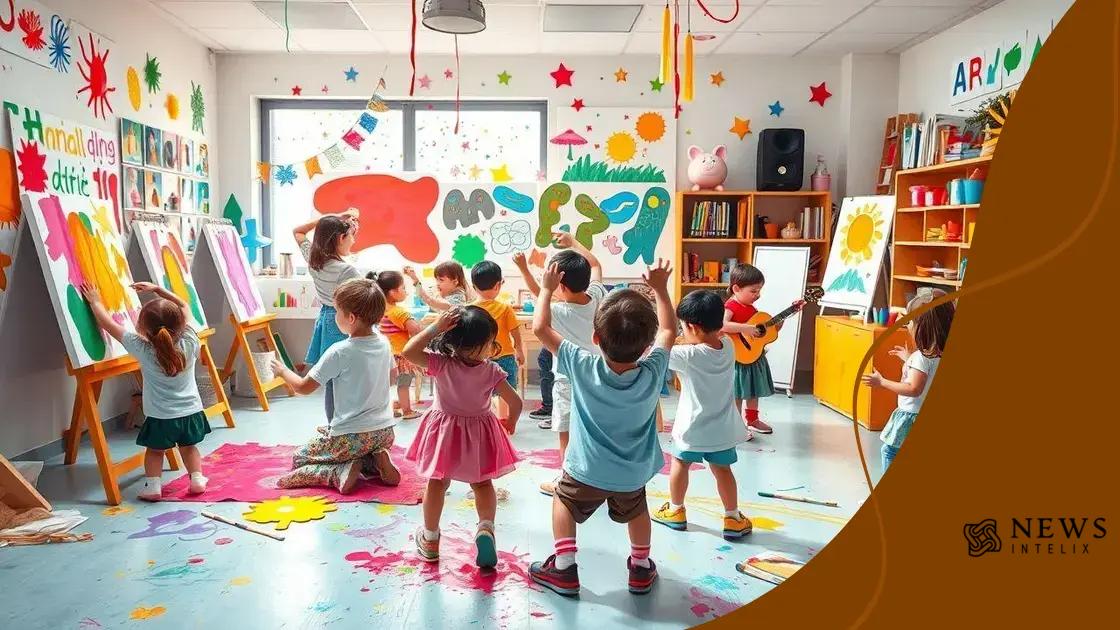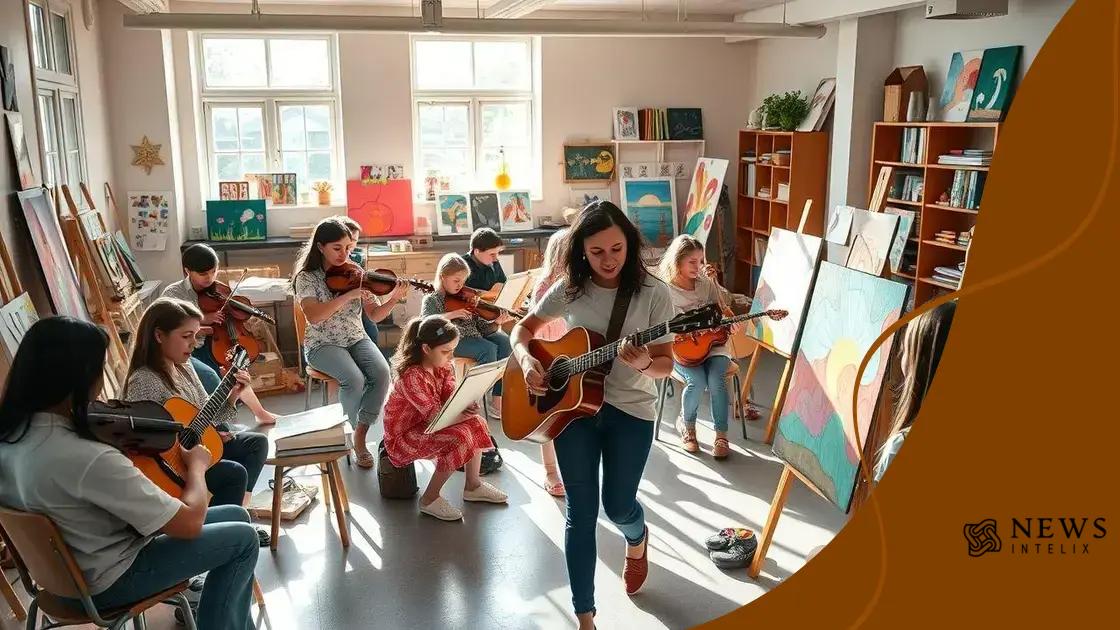Arts funding restored in schools: a step forward for creativity

Restored arts funding in schools enhances student creativity and engagement, leading to improved academic performance and fostering vital skills such as critical thinking and teamwork through diverse arts programs.
Arts funding restored in schools is more than just budget adjustments; it represents a renewed commitment to fostering creativity among students. Have you ever wondered how such programs can transform the school experience? Let’s dive into this topic together.
The importance of arts education in schools
Arts education plays a crucial role in fostering creativity and innovation among students. When schools make arts education a priority, they open doors to various forms of expression, allowing students to explore their talents and interests.
One significant aspect of arts education is its ability to enhance cognitive skills. Engaging in activities like music, dance, and visual arts can improve memory, problem-solving, and critical thinking. Studies show that students involved in the arts perform better academically as well, demonstrating higher test scores compared to their peers.
Benefits of Arts Education
Investing in arts education provides numerous benefits for students and schools alike. Here are some key advantages:
- Enhances Creativity: Arts programs encourage students to think outside the box and develop unique solutions.
- Boosts Academic Performance: Students active in the arts often excel in other subjects due to improved focus and discipline.
- Promotes Emotional Expression: Arts provide a safe space for students to express their emotions, reducing stress and anxiety.
- Fosters Teamwork: Collaborative projects in arts classes help students learn valuable teamwork skills.
Furthermore, arts education promotes cultural awareness and appreciation. By engaging with various art forms, students learn about different cultures and histories, enriching their understanding of the world.
With restored funding, schools have the opportunity to reintroduce and expand their arts programs. This not only benefits students but also strengthens the school community by attracting families and encouraging local partnerships.
In summary, the importance of arts education in schools cannot be overstated. It empowers students to develop their skills, enhances their learning experience, and equips them with vital life skills that extend far beyond the classroom.
Recent changes in funding policies
Recent changes in funding policies have significantly impacted arts education in schools. These adjustments can create new opportunities for students to engage in creative activities.
One major shift has been the increase in government grants aimed at supporting the arts. Schools can now apply for funding that specifically targets arts programs. This financial support helps cover costs related to supplies, equipment, and resources for teaching various forms of art.
Key Changes in Funding Policies
Several notable changes in funding policies have emerged in recent years:
- Increased State Funding: Many states have begun to allocate more funds specifically for arts education within public schools.
- Partnerships with Nonprofits: Schools are now forming partnerships with nonprofit organizations that provide arts programming and funding support.
- Emphasis on Creativity: New policies recognize the importance of creative skills in education, leading to more robust funding for arts initiatives.
- Community Involvement: Local communities are stepping up to support funding through events, donations, and grants.
These changes reflect a growing recognition of the role that the arts play in student development. Research indicates that students involved in the arts perform better academically, which has encouraged policymakers to prioritize arts education.
Moreover, advocacy groups have played a critical role in pushing for these policy changes. They highlight the benefits of arts education not only for personal development but also for future workforce needs. With these shifts in funding policy, schools can now offer more diverse and inclusive arts programs.
This renewed focus has the potential to transform how arts are taught, ensuring that every student has access to enriching experiences.
How restored funding impacts student engagement

Restored funding has a remarkable effect on student engagement, especially in arts education. When schools receive more financial support for their arts programs, students become more interested and involved in their learning.
One of the key impacts of increased funding is the ability to offer a wider variety of courses. Schools can introduce new classes in music, drama, visual arts, and dance. As students explore these options, they often find passions and talents they didn’t know they had.
Effects of Arts Funding on Engagement
Here are some ways in which funding restoration boosts student engagement:
- More Resources: Increased funding allows schools to purchase supplies, technology, and instruments necessary for effective arts education.
- Qualified Teachers: Schools can hire specialists for arts education, providing students with expert instruction and guidance.
- Extracurricular Opportunities: With more funding, schools can offer extracurricular activities like theater productions, art shows, and music performances.
- Community Involvement: Funding often brings in partnerships with local arts organizations, creating more engagement opportunities for students.
Students who participate in arts education are often more motivated and committed. They develop a sense of belonging and community. When students can express themselves creatively, they build confidence and social skills. This engagement leads to improved attendance rates and academic performance in other subjects as well.
Moreover, the presence of vibrant arts programs can transform the entire school environment. A culture that values creativity encourages collaboration among students. It fosters a positive atmosphere where everyone feels empowered to share their ideas.
In essence, restored funding for arts education is not just about the arts; it’s about nurturing well-rounded, engaged students who are prepared to face the challenges of the future.
Case studies of successful arts programs
Examining case studies of successful arts programs reveals the positive impact of arts education on students. Schools that have embraced arts programs often share inspiring stories of growth and achievement.
One notable example is the Visual Arts Program at Lincoln High School. By securing funding through grants, the program expanded its offerings and started after-school art clubs. Students who participated showcased remarkable improvements in their creativity and self-expression, leading to higher overall satisfaction in school.
Notable Success Stories
Here are a few more compelling case studies that highlight successful arts education initiatives:
- Harmony Music Academy: This program integrated music education into the curriculum, resulting in a noticeable increase in student attendance and engagement.
- Creative Minds Theater: A drama program that helped students develop confidence and teamwork skills through collaborative performances and plays.
- Art for All: An inclusive arts initiative that provided underprivileged students with access to art supplies and classes, dramatically enhancing their artistic skills and opportunities.
- STEM to STEAM: A program that combined arts with science and technology, demonstrating that creativity enhances critical thinking in students.
These programs not only improved students’ artistic skills but also increased their connections with peers and teachers. Participation in these arts programs leads to a stronger sense of community within schools, making learning more enjoyable and impactful.
Moreover, students involved in successful arts programs often report increased motivation in other academic subjects. Art projects encourage them to collaborate, problem-solve, and think critically, skills that are transferable across the curriculum.
Overall, the success of these case studies exemplifies the profound effects of sustaining and restoring arts education within schools. They showcase the potential for creativity to transform the educational experience for students.
Future implications for arts education
Understanding the future implications for arts education is vital as we see funding restored in schools. As more resources are allocated, the potential for innovation and growth in arts programs expands significantly.
One key implication is the increasing integration of arts with technology. As schools embrace digital tools, students will have the chance to explore new mediums, such as digital art and music production. This not only enhances creativity but also prepares students for careers in evolving fields that value artistic skills.
Expected Developments in Arts Education
Here are some anticipated trends that may shape the future of arts education:
- Interdisciplinary Learning: Arts education will increasingly intersect with other subjects, promoting a holistic learning approach that combines creativity with critical thinking.
- Community Collaboration: Schools are likely to partner more with local organizations and artists, bringing real-world experiences into the classroom.
- Focus on Diversity: Programs may expand to include diverse cultural expressions, allowing students to learn about global perspectives through the arts.
- Emphasis on Mental Health: Increased recognition of the benefits of art for emotional well-being may lead to programs designed to support mental health through creative expression.
Additionally, as society values creativity more, arts programs can lead to greater student engagement and retention. Students involved in arts education tend to develop stronger social skills and improve their collaboration abilities, which are essential in today’s workforce.
The inclusion of arts education in school curriculums will also influence future educational policies. Policymakers and school administrators will need to advocate for resources, with an understanding that arts education plays a crucial role in developing well-rounded individuals.
Overall, the future of arts education appears promising, highlighting its key role in shaping not just students’ creative skills but also their academic and social growth.
FAQ – Frequently Asked Questions about Arts Funding in Schools
How does restored funding impact student creativity?
Restored funding allows schools to expand arts programs, providing students with more opportunities to explore their creativity and develop their artistic skills.
What are the academic benefits of arts education?
Arts education has been linked to improved academic performance, as students engaged in the arts tend to have better focus, critical thinking skills, and overall motivation.
How can arts programs foster community involvement?
Arts programs often partner with local organizations and artists, creating opportunities for students to engage with their community and participate in collaborative projects.
Why is interdisciplinary learning important in arts education?
Interdisciplinary learning encourages students to make connections between different subjects, enhancing their overall understanding and application of knowledge in real-world scenarios.
